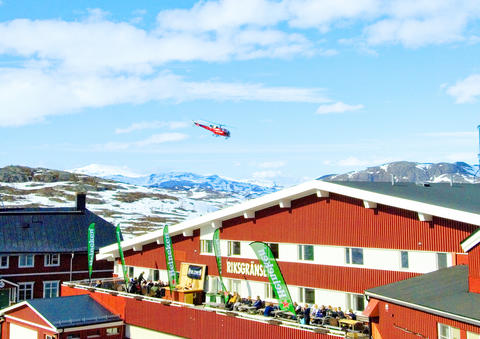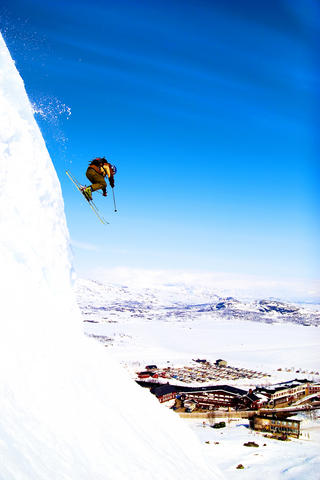The nightclub in the basement of the Riksgransen Hotel is full of surprises. The first is the US$24 bill for two pints of lager. Then the barman pulls back a curtain to reveal that, even though it's 10pm, because it is May and we are so far north, outside it's broad daylight. But the coup de grace is when a helicopter lands right outside and four weary but beaming skiers unfurl themselves from its cramped cockpit and clomp inside for a drink.
Riksgransen is the world's most northerly ski resort, a frozen border post between Sweden and Norway, 300km north of the Arctic Circle. Such latitude gives it a key selling point - a ski season extending until late June. When the snows melt in Chamonix, St Anton and Verbier, the ski bums who can't face heading home migrate here to prolong winter for a few more precious weeks.
But there is another, lesser-known, reason for making the pilgrimage this far north. Ironic as it may seem given Scandinavia's reputation for ruinous prices, Riksgransen is probably the cheapest and easiest place in the world to get a taste of heliskiing.

PHOTO: COURTESY OF MATTIAS JOHANSSON
For any skier or snowboarder who has ventured off-piste and felt the addictive thrill of floating in light powder snow, heliskiing is the stuff of fantasy. Rather than queuing for busy cable cars and chairlifts, heliskiers are whisked away to remote peaks, below which kilometer after kilometer of virgin powder awaits. The only drawback is that the cost of chartering helicopters means that it's an activity pretty much reserved for those who work in banking. The majority of Britons who go heliskiing do so in British Columbia, Canada, signing up for a week's package that costs around US$8,000 per person, plus another US$2,000 for flights, transfers, drinks and so on.
In Riksgransen, however, things are far more low-key. You can do as many helicopter lifts as you like, typically paying just US$100 a time, including a guide and hire of transceivers, shovels and probes. Most take a three-lift package, which will take a full afternoon and allow you to ski the biggest peaks of the area.
There's no need to book months ahead either - you just sign up at the hotel reception desk in the morning, leaving your mobile number, then head out to the pistes. An hour before your helicopter slot, the guides ring to call you back to the helipad, right outside the hotel.

PHOTO: COURTESY OF MATTIAS JOHANSSON
SMALL-SCALE RESORT
It has to be said that the pistes here are rather limited - there are only six lifts - but then Riksgransen isn't really a resort in the conventional sense. There's just one hotel, around which a cluster of red wooden outbuildings have grown up, and a maximum capacity of about 600 people. The whole place owes its existence not to skiing, but to the single-track railway that runs through its center, built to transport iron ore from the mines of Kiruna in the south to the port of Narvik, on Norway's Atlantic coast.
The railway was completed in 1902, when rails being built from the Swedish and Norwegian sides finally met at Riksgransen. To celebrate, a hotel and elaborate wooden station were built, and the railway company started trying to promote it as a tourist destination. Initial attempts foundered (there was, after all, no real reason to get off the train) until the country's first ski school was established here in 1934. Its popularity has slowly grown ever since, although today it still feels more like a frontier outpost than a town.

PHOTO: COURTESY OF MATTIAS JOHANSSON
When our call comes, we rush down from the pistes and gather excitedly at the empty helipad. Soon the little red helicopter comes into view across the frozen lake that fills the wide valley floor. As it gets closer, I start to suspect there's a reason heliskiing here is so cheap; to be blunt it doesn't exactly look new.
Most helicopters I've been in before have been all lightweight fiberglass and carbon. This is made from painted metal and rivets and glass and has big silver door handles that look as if they've been borrowed from an Austin Allegro. Later inquiries reveal it's an Alouette 3 of a type first built in 1970, but Krister, our guide, assures us that the exhaustive maintenance regime means its age makes no difference.
Soon the rotors are spinning, smacking the air with a slow thud, thud, thud that gradually speeds up into a frantic whirr. Then we're soaring up over the hotel, leaving behind the few skiers on the pistes and heading off into the Arctic wilderness. We touch down on the 1,463m summit of Vassitjakka, clamber out and crouch in the snow as the pilot lifts off and veers sharply away to pick up the next group. There's a moment of exquisite silence as we take in the view stretching over kilometer after kilometer of white Arctic plateau, past the ancient blue ice of glaciers and down, in the far distance, to the half-frozen fjords of Norway. Then everyone's bashing snow off their boots, clipping into bindings, banging poles and talking about the run ahead.
ARCTIC THRILLS
It doesn't disappoint. We carve huge high-speed arcs in the buttery spring snow, leaving enormous S-shaped signatures on what had been an untouched mountainside. The initial steep slopes level and open out into a wide hidden bowl, devoid of any sign of human life. While the big helicopters in Canada can carry groups of up to 10 clients, the Alouette has space for just five, so our group is small enough not to destroy the peace.
Halfway down, a family of reindeer are pulling at an exposed clump of grass, and Krister warns us to give them a wide berth in case they panic and scatter into our paths. We take our time, each choosing a separate route, then regrouping at the bottom, where Krister radios for the helicopter to collect us for two more wonderful runs. There hasn't been any new snow for a couple of weeks, but the temperatures here and the lack of other skiers means that conditions are still great. To be honest though, the real thrill is less about the helicopter and the powder snow, more about the feeling of skiing in a tiny group in a wilderness utterly unlike the Alps.
When we land back at the hotel, the party is in full swing. On the terrace young free riders from around Europe are drinking and soaking up a rare interlude of Arctic sun. Though there's only one hotel, it does a good job of catering to everyone. So while the best rooms in the Meteorologen Lodge, a boutiquey place housed in Riksgransen's oldest building, go for around US$400 a night, there are also bunk-bedded rooms for young ski bums costing US$80 per person per night. In the Lapplandia restaurant, the tasting menu includes lightly smoked leg of reindeer with chanterelle sformato, followed by rowanberry granita, and will set you back US$80, but there's also a coffee shop and small food store selling far cheaper fare to satisfy the young, impoverished snow addict.
We ease off our boots and head back to the nightclub to count our krone. We've saved so much on the heliskiing we can afford another beer ... just.
Rooms at the Riksgransen Hotel (www.riksgransen.nu) cost from US$80 per person per night. VisitSweden (www.visitsweden.com) has further details.

June 2 to June 8 Taiwan’s woodcutters believe that if they see even one speck of red in their cooked rice, no matter how small, an accident is going to happen. Peng Chin-tian (彭錦田) swears that this has proven to be true at every stop during his decades-long career in the logging industry. Along with mining, timber harvesting was once considered the most dangerous profession in Taiwan. Not only were mishaps common during all stages of processing, it was difficult to transport the injured to get medical treatment. Many died during the arduous journey. Peng recounts some of his accidents in

“Why does Taiwan identity decline?”a group of researchers lead by University of Nevada political scientist Austin Wang (王宏恩) asked in a recent paper. After all, it is not difficult to explain the rise in Taiwanese identity after the early 1990s. But no model predicted its decline during the 2016-2018 period, they say. After testing various alternative explanations, Wang et al argue that the fall-off in Taiwanese identity during that period is related to voter hedging based on the performance of the Democratic Progressive Party (DPP). Since the DPP is perceived as the guardian of Taiwan identity, when it performs well,

A short walk beneath the dense Amazon canopy, the forest abruptly opens up. Fallen logs are rotting, the trees grow sparser and the temperature rises in places sunlight hits the ground. This is what 24 years of severe drought looks like in the world’s largest rainforest. But this patch of degraded forest, about the size of a soccer field, is a scientific experiment. Launched in 2000 by Brazilian and British scientists, Esecaflor — short for “Forest Drought Study Project” in Portuguese — set out to simulate a future in which the changing climate could deplete the Amazon of rainfall. It is

Artifacts found at archeological sites in France and Spain along the Bay of Biscay shoreline show that humans have been crafting tools from whale bones since more than 20,000 years ago, illustrating anew the resourcefulness of prehistoric people. The tools, primarily hunting implements such as projectile points, were fashioned from the bones of at least five species of large whales, the researchers said. Bones from sperm whales were the most abundant, followed by fin whales, gray whales, right or bowhead whales — two species indistinguishable with the analytical method used in the study — and blue whales. With seafaring capabilities by humans